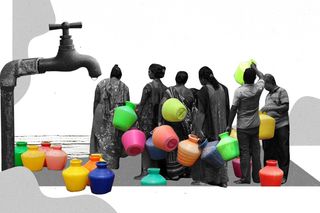
India Has No Urban Drought Policy, Leaving Cities Unprepared, Vulnerable
Without policies specific to urban water scarcity, cities are relying heavily on peri-urban and rural resources in times of crisis.

In 2019, drought gripped Chennai, taking the city by surprise, for it had received around 800mm of rain the previous year. Farmers in nearby villages abandoned crop growth and chose to dig up borewells, because water was now an urgent investment. The city’s IT firms, hotels, and schools even shut down, citing a lack of water to carry out regular operations.
Drought is called a slow-onset disaster, and in this case, it was slow and unusual. The last time Chennai dealt with a disaster was a huge flood in 2015, and there clearly was no natural reason for the city’s water to dry up, until experts and activists pointed out that the city’s reservoirs had dried up.
“Chennai is endowed with fantastic reservoirs, but they’re encroached upon [by urbanization], clogged and silted up. The catchment areas are disappearing. There’s no periodic maintenance,” activist and journalist Nityanand Jayaraman told NPR, outlining the cause of drought as city-level inefficiency and mismanagement.
Several other Indian cities like Bangalore, Delhi, and Mumbai have dealt with droughts before, leading to massive water shortages and inequity — especially in urban poor areas. Yet, India does not recognize the presence of urban droughts because India’s adopted policy definition of droughts comes from the National Commission on Agriculture, and Indian droughts’ reported impacts only include deficits in agricultural production, loss of rural livelihoods, food, and water insecurity.
Though India’s drought policy recognizes several urban causes of droughts, like poor land-use practices, population rise, and environmental degradation, it does not recognize the impact of these causes, making the Indian government not well equipped enough to deal with urban water scarcity.
“Urbanization is merely seen as a ’cause’ for increasing water scarcity but experiences of [losses and damages] in urban areas remain under-studied,” says Garima Jain, a public policy researcher who co-authored a research paper on urban droughts published in Current Opinion in Environmental Sustainability. This is detrimental to policies that attempt to curtail drought, because the definitions of disasters have a huge bearing on how they’re dealt with.
Looking at urban droughts in policy, specifically, is necessary, considering the world’s rapid urbanization and its consequences, like exacerbated water insecurity, variable rainfall caused due by global climate drivers, land-use changes, and urban population growth. Research estimates that 410 million more people will face urban droughts with a 2° increase in global warming — especially cities in East, West, and South Asia. The Ministry of Housing and Urban Affairs has previously suggested that the minimum urban water supply should be 135 liters per person per day. In reality, water-scarce areas in India receive a maximum of 35 liters per person per day, making people in these water-scarce regions more vulnerable to infections.
Related on The Swaddle:
Nagaland Likely to Face Severe Drought After 10 Years Due to Delayed Rainfall
Defining urban droughts as a unique problem with its own unique solutions will also do away with heavily relying on peri-urban and rural resources to cope. During Chennai’s 2019 urban drought, the city was dependent on private water tankers, which brought in water from peri-urban village areas, leading to a severe depletion in the rural areas’ groundwater levels. This put the rural water access and livelihoods under stress — specifically women, who were worst hit by the loss of agricultural employment and who created several movements and communities to defend their rights to water.
Paying attention to urban droughts will also drive more attention towards urban poor regions, where water insecurity is the norm.
Gender dynamics in India place women as retrievers of water in both rural and urban spaces. Over 63 percent of Indian households do not have water access within their homes, which means a large number of both urban and rural women spend their time fetching water. Women residing in a Delhi slum stated they had to wake up at 2 a.m. and join a queue to fill bottles of water. In drought conditions, water insecurity significantly increases, placing a greater domestic, financial, and health burden on these women, who also must work for a living.
Gender isn’t the only factor. In Mumbai’s Shivaji Nagar — a Muslim/Dalit majority slum — water insecurity has remained a steady issue for several decades due to the geographic distance between the region and the reservoir that supplies water to nearby areas. Individuals living in this area are marginalized to the extent where they don’t have relevant proofs of residence or identity cards, which means that the city’s municipal corporation is not legally obligated to resolve their water crisis. According to a 2020 survey, the lockdown made the water crisis in Shivaji Nagar so bad that 12% of over 600 residents said they had to borrow money to buy water.
And this is during non-drought conditions; during drought, the water supply is even more erratic, which means people have to rely on private water tankers, which may cost up to several thousand rupees.
Changing how droughts are defined may help change the way droughts are contained. India’s official drought management protocol has three steps — monitor drought intensity, declare drought, and manage drought. But experts recommend doing away with linear approaches and adopting dynamic ways to help ensure that urban areas remain prepared for drought. Notable examples of the same include Cape Town, South Africa, which built a resilience strategy for future shocks and stressors, ranging from droughts to substance abuse. Their resilience framework for urban drought notably also helped them manage the Covid19 pandemic. Beijing, China also invested in large-scale urban water transfers and rainwater harvesting. Closer home, the Tamil Nadu government passed a law in 2003 requiring all buildings to harvest rainwater.
While these interventions attempt to be predictive and dynamic, they are still attempts to adapt to previous crises due to the current lack of proper research on the impact of urban droughts. Though the Tamil Nadu 2003 law helped raise the state’s water table, the effect was short-lived due to lack of maintenance according to the Central Ground Water Board. In comparison, a more informed approach driven by increased research and policy interest in preventing urban droughts can actively help prepare for problems that adaptive approaches cannot solve.
As India moves towards a development-centric approach, preparing for its inevitable effects is imperative. Defining urban droughts will both increase attention towards urban water insecurity and help cities prepare for all future drought incidences. For urban droughts, much like rural droughts, have far-reaching impacts that extend beyond a city’s boundaries.
Aditi Murti is a culture writer at The Swaddle. Previously, she worked as a freelance journalist focused on gender and cities. Find her on social media @aditimurti.
Related


Why We See ‘Human Faces’ in Objects Sometimes
